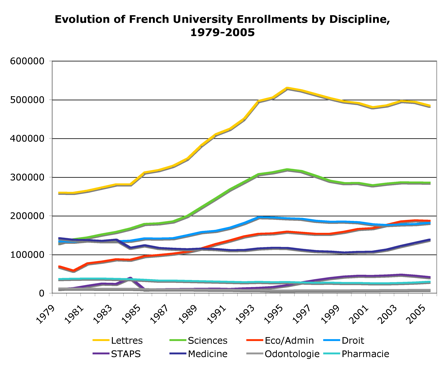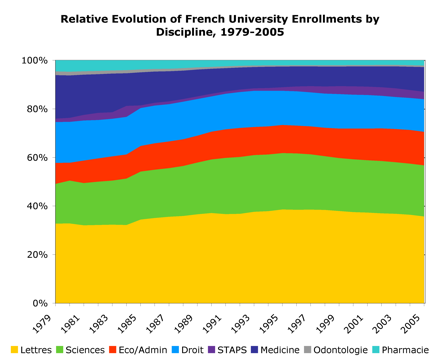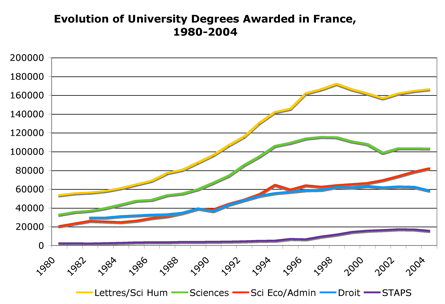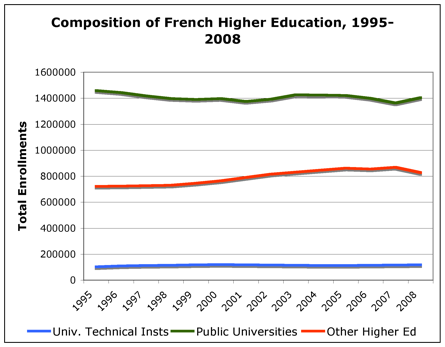If you want to get a sense of the overall institutional situation of French universities, it helps to look at how many French students are studying what. In this post I just want to present a basic, broad overview of the situation.
There’s a lot to see here. You can see what sociologists call the “second massification” of the universities, a period of major growth from something like 1985-1995. Almost every discipline is rising. The largest disciplines are not, actually, the ones with the most growth. That dubious honor goes to the field called STAPS, which stands for Sciences et Techniques des Activités Physiques et Sportives, which we could translate loosely as Athletic Sciences. STAPS grew from 10,947 enrolled students in 1979 to 41553 in 2005 — a 3.8-fold increase! The similarly tiny fields of dentistry (odontologie) and pharmacy, on the other hand, actually shrunk, though you can barely see them because they get lost in the bottom of the graph.
Let’s look more closely at the major disciplines. Letters and human sciences here are labeled lettres; they’d probably be called humanities and social sciences in the U.S. Anyway, it’s striking that they constitute the largest sector of French higher education, with around half a million enrollees. They have almost doubled in size since the 1980s, though they have also been in a steady, slow absolute decline since the mid-nineties. The sciences are smaller, but show a similar trend. The business-oriented disciplines of Eco (here short for Sciences Economiques) and Admin (Administration économique et sociale) have grown somewhat more, by a factor of 2.7, and seem to have on the whole one of the most consistent, steady rises of any field. Law (droit), which presumably leads to both private and public-sector careers but at any rate to a secure professional identity, has grown somewhat and leveled off, while its cousin medicine has on the whole slightly declined. (Law and medicine are the two most traditional professional fields in the traditional French university.)
To get a better sense of the changing demographic composition of these enrollments, it’s helpful to look at a chart that shows each discipline’s proportional share of university students:
The wider the band, the larger a discipline’s share of the university’s student body… Here you can see that medicine and pharmacy have greatly declined, leaving space for every other field to broaden. In terms of absolute numbers, mind you, medicine and pharmacy are about where they were, 140,000ish in medicine and 30,000ish in pharmacy; but as a share of the university as a whole, they are dwindling.
Something that really strikes me, looking at this diagram, is that letters and human sciences are not even in a state of proportional decline within the university system. In fact they have grown a bit. Of course, if we look further at the internal distributions within the human sciences, we’ll find that the growth is preferentially concentrated in new vocationally-oriented disciplines (educational sciences, for example). I’ll look at that in a future post. But it’s striking to see growth in these fields, which are the exact ones not considered “future-oriented” by contemporary “knowledge society” policymakers.
For another point of comparison, it’s helpful to look at the disciplinary distribution of degrees actually awarded:
The magnitude of these figures is much lower, three times lower or so; that’s unsurprising since we can assume that it takes a few years of enrollment for students to get a degree, and some drop out along the way. (This graph, unfortunately, lacks the medical fields listed on the other one.) Anyway, the basic distribution is similar, with letters and human sciences at the top, sciences above that, and then law and econ. I note that the “peak” in letters and sciences is a year or two later on this graph – 1998 instead of 1995. Needless to say, that’s what we would expect and want to see, since that indicates that, indeed, a couple of years separate the entrance of a big group of students from the time when this group gets its degrees. (I’m also struck, in passing, by the fact that law and econ/admin track each other much more closely on this graph than on the other one; I don’t have a good explanation for that right now.)
To really understand what’s going on in French higher ed, however, we have to look at the place of the university system within the broader higher educational landscape, which has a million kinds of technical schools, private schools, art and architecture schools, specialized teacher training institutes (now being demolished or integrated into the universities, depending on your point of view), and the like. The first thing to do is see how much of the total higher ed world is encompassed by the public university system we’ve been looking at:
As you can see, the public universities continue to serve the vast majority of university students. (Note that the “University Technical Institutes” mentioned here are actually part of the universities, and are included in their total size; the blue line just indicates a subsection of the population tracked by the green line.) Nonetheless, university enrollments are in what looks like a slow decline, while other higher educational institutes are slowly rising. (I actually don’t know what explains the sudden dip in “Other Higher Ed” in 2008 and the slight rise in the universities; there could be some organizational restructuring that would account for it.)
Now, to get a clearer idea of what people across the French higher ed system are studying, we can consider a graph that shows changing proportions of total enrollments across different university and non-university sectors:
The bottom segments designate the university fields we looked at earlier – letters, sciences, economics/administration, law. The top segments designate different fields from the non-university world — tech schools, teacher training, art and architecture and social services, pure management schools (I should probably have just labeled them “business schools”; they’re mostly private schools), the tiny private university sector, etc. I did make one mistake here, actually, which was to lump all health-related fields together; this means that medicine, a university field, is put together with paramedical training, which are taught elsewhere. This does help us to see that health fields as a whole are rather large, even if medicine itself isn’t growing much (as indicated above).
One thing that this chart shows us very clearly is that, looking at the system as a whole, the letters, human sciences, and sciences are in relative decline. Of course as a matter of absolute numbers, almost everything has grown, as we saw above. But the major relative growth here seems to be in tech schools, maybe in some aspects of health sciences, in engineering, in management. That doesn’t mean these fields are demographically dominant; they’re not. But their share of the students is rising.
In future posts on these demographic issues, which I’m only just beginning to really understand, I want to look at the changing class composition of university students; I want to look at the changing makeup of the disciplines within letters and human sciences; and I’d like to compare the progress of vocationally-oriented higher ed with its status in the U.S. Are business schools proportionally bigger in the U.S. than in France, for example? That would be my guess.
p.s. — if you have ideas on how to make the presentation of these necessarily abstract demographic questions any more, well, exciting, I am actively interested in that!





I’ve been reading your blog with interest, but there’s a point I was hoping you could clarify for me. How are doctoral programs organized in France? In the U.S. system (as you’re well aware, of course), doctoral programs are attached to departments. My PhD, for instance, is from the communication arts department at the University of Wisconsin.
But I was looking at the liste des doctorats at the Université Paris VIII — http://recherche.univ-paris8.fr/red_list_doc.php — and clicking through different links. For instance, I looked at the doctorat sciences de l’information et de la communication (since it’s close to my own discipline), which pulls up a list of names of enseignants chercheurs, not a department. When I click on the different names, the research centers to which the enseignants chercheurs are affiliated come up, but again, not a department.
In some ways, my question is rather tangential to the rest of your posts, but I’d be very interested to know how the system works in France.
Thanks!
Hi Kyle, nice to hear from you. This is something I find a little confusing too, but basically the way it seems to work is that, at least in public universities, doctoral schools (écoles doctorales) are somewhat separate organizationally from regular academic departments (which give undergrad and master’s degrees). At Paris-8, for instance, a philosophy Ph.D. would be obtained through a philosophy section of an interdisciplinary doctoral school called Pratiques et Théories du Sens. You have to have a kind of second doctorate (a Habilitation à Diriger des Recherches) to advise phd students in France, which only senior faculty normally have, but pretty much all the senior faculty of the regular philosophy department are associated with this doctoral school. So socially and intellectually it seems like pretty much one unit; it’s only organizationally separate. (Also, though this verges on the level of trivial detail, the doctoral seminar room is in a different building and is much less decrepit than the rest of the philosophy spaces.)
At Paris-1, on the other hand, there’s a separate école doctorale just for philosophy. My guess is that other disciplines are at least similar to one of these two examples, but I haven’t really checked. I would assume that at the grandes écoles, or at least EHESS, it’s a totally other system too… anyway, I’ll let you know if I find out more!
best, Eli
Thanks for the explanation. That’s a fascinating way to organize doctoral studies. After reading your reply, I poked around a bit more on the Paris 8 website, looking specifically at the écoles doctorales. It appears that organizing programs this way refocuses (or has the potential to refocus) students’ attention on the objects of study, rather than questions of disciplinary boundaries, whereas in the U.S., at least in the field of communication, there’s always the possibility that loyalty to one method over another predetermines some of the questions researchers ask. Of course, I’m generalizing here, both about the U.S. system and the French system, but on the surface at least, I like the logic that seems to shape the French approach.
(If I had the time, money, and general inclination — which I don’t, really, but if I did — I would take a serious look at the doctoral school focusing on théorie et pratique du sens. Sounds like fun!)
Thanks again, and I’ll be following the blog with interest.
Kyle, I want to see if I understand your comment. Would you predict that within a discipline, French doctoral students (and faculty?) will exhibit more variation in their methodological approach and less variation in subject matter?
Eli, my tip for presenting this data (which I think is great!) is that you consider labeling the lines/points directly rather than using a legend. It often makes graphs much easier to read.
Other things that jump to mind:
The variation in graduation rate across different disciplines is probably worth exploring. Seeing enrollment/graduates as a percentage of the 18-25 year old age cohort would be nice. I’d like to know the average labor market outcomes and subjective well-being for people finishing the different courses of study, even though these numbers would hide the, perhaps more important, variation within each category.
btw, I think survey measures of subjective well-being are really interesting, but I find people often mis/over-interpret them.